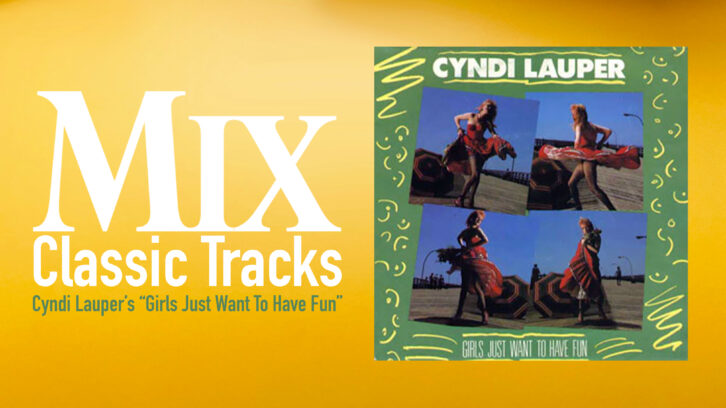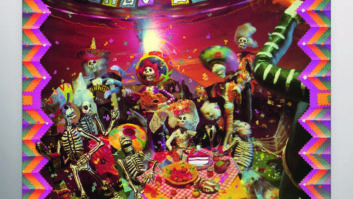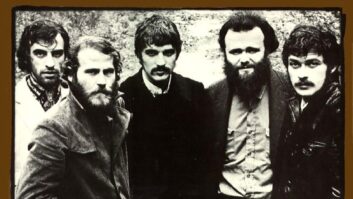
This article was first posted April 1, 2004.
Much the way Britney Spears and Christina Aguilera have been played off against each other in the press in recent years, Cyndi Lauper was often compared to Madonna in 1983 and 1984, the years Lauper made her solo debut with She’s So Unusual and Madonna released her first two discs. Lauper and Madonna presented two highly different versions of the female pop icon: one, a street-savvy Catholic-girl-gone-bad for whom sex and ambition went hand in hand; the other, a quirky, day-glo-haired rebel who combined pop divahood with a punky, new wave sensibility. Two of the singles that helped define their early careers emphasize this contrast: Madonna’s “Material Girl” was the portrait of the ultimate pragmatic seductress, while Lauper’s “Girls Just Wanna Have Fun” offered a playful perspective on female independence. Of the two singers, Lauper had the serious vocal chops: Her voice displayed a range and power that Madonna, though ultimately better at staying on top of the pop game, couldn’t match.
“Girls,” like the rest of She’s So Unusual, is full of artful musical touches that complement Lauper’s off-the-wall singing — the bouncy cartoon-reggae groove, the outlandish keyboard solo mid-song, the over-the-top background vocals. The studio team responsible for the song was the same one behind the hit ’80s band, The Hooters: Rob Hyman (keys), Eric Bazilian (guitar), producer Rick Chertoff and engineer William Wittman. Chertoff met Hyman and Bazilian in college and, according to the producer, “We always stayed in touch and always were trying to work together in some way that would be fun.” (The four continued to collaborate on and off after Lauper’s album, scoring another big success in 1995 with Joan Osborne’s Grammy-nominated debut, Relish.)
Chertoff remembers the genesis of the concept for She’s So Unusual: “I was jealously guarding some songs that I thought were great in my desk drawer at Columbia,” he says.
“‘Girls Just Wanna Have Fun;’ ‘All Through the Night,’ that beautiful Jules Shear song; ‘Money Changes Everything’ — and I had an idea about how to recut that Prince song, ‘When You Were Mine.’ For me, they were really important pieces of some project, and I was looking for a Cinderella to kind of fit that slipper.” During a cross-country flight, he mentioned his idea to Portrait Records executive Lennie Petze, who recommended a singer he’d been trying to sign from a band called Blue Angel. Chertoff soon met Lauper, and his slipper found its foot. Lauper, however, was definitely not the passive princess type. “The songs that I had originally made up a good part of the record, but Cyndi’s goal was to write as much as she could around those,” Chertoff says. Lauper ended up co-authoring three of the album’s songs, including the Gold single “Time After Time.”
“Cyndi and Rob Hyman from The Hooters wrote that song while I was running around breaking down drum mics,” assistant engineer John Agnello recalls. “It was pretty inspiring.”
Chertoff knew all along that “Girls Just Wanna Have Fun” was important to the recording. “I first heard it from Rob Hazard, who was trying to get his own record deal back then and eventually did. He had his own band called Robert Hazard & The Heroes. This particular song of his always struck me as being something interesting and fun and sort of poignant in its own way, and I knew that it was a cornerstone of my record with Cyndi.”
It was another thing, however, to win Lauper over to the idea. “I sort of had to do a little convincing with her,” Chertoff says. “I remember that rather than letting the song demo that I had be the only thing that could impact Cyndi on her choice of whether or not we should do this song, I decided to drive her down to Philly — we both lived in New York at the time — to see a performance of Robert Hazard & The Heroes.
“In the middle of the show, people are standing, cheering, hanging on every note, just the right atmosphere for me to try to sell this concept to Cyndi. As a young producer back then, I knew how important it was, so I was determined to try to show it to her in the best light and have her love it. Anyway, in the middle of this show, they play the song and people are cheering. But in the middle of the song, Cyndi shouts in my ear, ‘I will never do that song!’”
Chertoff says he was “devastated” by Lauper’s reaction. But he was also determined, and throughout the three-hour ride back to New York, he debated with her. “Philosophically, she thought it was a sexist song. Politically, we were on the same page: I wouldn’t have wanted to do a sexist kind of song, but I didn’t feel it was that.” By the time they got home, they still had not reached a conclusion and the debate continued for several weeks until Chertoff came up with a winning argument. “I said, ‘Listen, Cyndi. I just woke up this morning thinking that one thing we haven’t talked about is if you sing it, it’s a whole different orientation than if a guy sings it.’ And I said, ‘Don’t answer now. Let’s just hang up and sleep another day on it.’ Anyway, long story short, to her credit, she called back the next day and said, ‘All right, I’ll do it.’ Ironically, I don’t know how many months later, she’s on the cover of Newsweek and Ms magazine and it’s a feminist anthem.”
Classic Tracks: Culture Club’s “Do You Really Want To Hurt Me”
It took several tries to find the right arrangement for “Girls.” Chertoff says that they had decided on a reggae approach, but initially weren’t satisfied with the takes they were getting with their in-house band, so they decided to enlist some help. “I remember that we were huge fans of Sly Dunbar and Robbie Shakespeare, who happened to be recording Infidels with [Bob] Dylan in New York City at the same time we were recording this record. We arranged to get them on an off weekend to come down and help us on that one track. I remember they were expensive and it was a big deal for me.” They worked for a day with Dunbar and Shakespeare but, according to engineer Wittman, the results didn’t match what they’d already gotten from bassist Neil Jason and drummer Anton Fig. (Fig currently plays with the Dave Letterman band.)
She’s So Unusual was recorded at New York’s Record Plant, using what Wittman calls “The Method,” a recording approach he and Chertoff developed on Lauper’s album and have used many times since. “We would lay down a drum machine, at that time it was a Linn drum, and we would overdub a guide track. In the case of ‘Girls,’ it was a guitar and the vox organ, which was playing the upbeats with the echo on it. That was kind of the basic layer. And then after we had a reference vocal, we would overdub real drums on top and then go back and replace the guide instruments. So everybody played to the drums, but we would sort of shape out the song and get a sense of the arrangement by laying down these guide tracks first.”
The drums were recorded in the Record Plant’s Studio B, which Wittman says contributed greatly to their sound. “We set Anton up in the middle of the room, which was not huge — about 35 by 25, and only an 11-foot ceiling — but it was unbelievably live. Every surface was hard, and it was very bouncy, splashy, nasty, live. Literally, if one person was talking on one side of the room, you might have trouble understanding them on the other side because of the scatter. So it was an incredible room for rock drums. And we set him up right in the middle to get maximum splash.”
In terms of drum miking, Wittman used what remains his basic setup with a couple of special modifications. “It was an RE-20 inside the bass drum, with a blanket over the drum to try to keep the sound out of the other microphones and make it sound closer. The snare drum was a Neumann KM84, the hi-hat was a KM86 and the toms were U87s. Overhead, I had Beyer M 160 ribbon microphones.
“And then I had one STC 4038 way up over the control room window and right up at the ceiling, right where the wall meets the ceiling — it was maybe 25 or 30 feet from the snare drum to this high, distant room mic,” says Wittman. “I supercompressed that distant room mic — squashed the hell out of it — made it really, really bright. Then I gated that with a Quad-8 noise gate, and I triggered the gate with a close snare mic, so when he hit the snare, it would open this distant room mic near the ceiling, and you would get that ‘gush’ sound — it was very compressed and white noise-y. That was recorded to a separate track. After the fact, we also added a distorted handclap off of an 808 — Eric Bazilian actually played it pretty much by hand, almost in real time to the track — that also had that white noise-y ‘gush’ sound, which was mixed in.
“Both the guitar and the vox organ were going through ’60s Vox AC-30 amplifiers,” Wittman continues. “Both of them were miked with one U87; pretty simple. We generated the delay that makes the double upbeats on the organ with a Publison [digital delay unit]. The effect was recorded with the sound onto the track.
“Also, the guitars were compressed with an LA-2A. Again, all that went to tape, so whatever effects or compression or EQ, I put it right on the tape. Pretty much, when you push the faders up, the sound is already there on those recordings. And I still do that. I like to know what it’s going to sound like, and I don’t like to have to re-create it every time you have to do an overdub or anything. I like to know that once you have something you like, you’re locked in.”
As far as mic pres, Wittman used only the ones in the API console at Studio B, “because when you have a console with terrific mic pres, there’s no reason to shop outside. I really think this trend of, ‘Oh, I want eight different mic pres’ came about because so many places started to have consoles that weren’t any good. If you had a great console, there was really no reason for outboard mic pres.”
Wittman recorded Lauper’s vocals with a Neumann U47, sending the signal through an API 525 compressor and the Publison delay. Half of the vocals on the track were cut in Studio B; the other half Lauper sang in a large storage room that she favored for recording, which was located behind the mix room and euphemistically dubbed “Studio E.” “Of course, we couldn’t see her. I think she lost some of her inhibitions in Studio E,” Chertoff says. This led to some humorous moments for the studio crew. “There was a moment where we swore she was talking to somebody out there and the room was empty,” Agnello says. “We ended up naming her fictional friend ‘Tony.’ Like, ‘She’s talking to Tony again.’”
The track’s wacky, skittering keyboard solo, one of its most memorable sections, turns out to have been a bit of studio serendipity. Rob Hyman played it on a Roland Juno 60 synth, nailing it on the first take. “It was like a big joke when we first did it, but then everyone was like, ‘That’s kind of awesome,’” Agnello says.
The mixdown was fairly laborious. Using the Record Plant’s 56-in TSM Trident Console, it was done completely manually, as the studio had not yet gotten automated equipment. “You literally would have to do a section at a time,” Agnello remembers. “Once you were finished mixing the actual song, you cut it all together, you would sit and listen back to it, and, ultimately, something would be not right, so you’d go back to that section, reset all the faders to that section and then do that and cut it in.” Wittman corroborates the description: “We would do that again and again, editing in small pieces until everything was corrected, so the final mix probably has 100 little edits in it. That was instead of automation.”
Ultimately, both “Girls” and She’s So Unusual went Platinum in the U.S., the latter six times over. And though she had a number of hits in the ’80s, several from her debut album, Lauper is still often remembered for the single that first brought her to the public’s consciousness. While her days of Top 10 hits may be over, Lauper continues to be well-regarded as a singer, and a recent cover album of jazz and pop standards, At Last, has given her career something of a comeback. But She’s So Unusual certainly earned her a place in the pop pantheon. It’s a well-crafted recording whose spirit of exuberant, musically savvy fun hasn’t faded a bit 20 years down the road.







